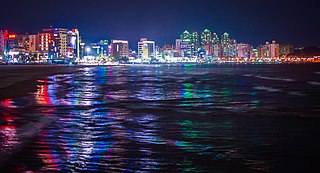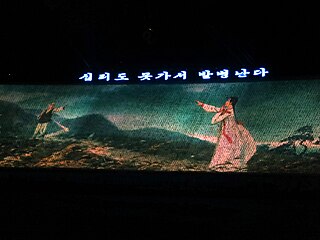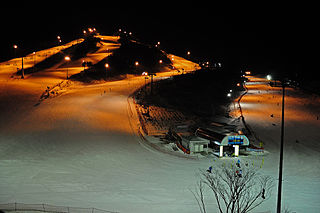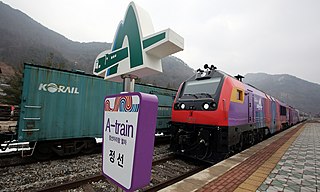
Gangneung is a municipal city in Gangwon State, on the east coast of South Korea. It has a population of 213,658. Gangneung is the economic centre of the Yeongdong region of Gangwon State. It has many tourist attractions, such as Jeongdongjin, a very popular area for watching the sunrise, and Gyeongpo Beach. The city hosted all the ice events for the 2018 Winter Olympics and the 2024 Winter Youth Olympics.

Gangwon State is a Special Self-Governing Province of South Korea and the least densely populated subdivision of the country. Gangwon is one of the three provinces with special self-governing status, the others being Jeju Province and Jeonbuk State. On the east bound by the East Sea, it borders Gyeonggi Province to its west, North Gyeongsang Province and North Chungcheong Province to its south, and the Military Demarcation Line to the north, separating it from North Korea's Kangwŏn Province. Before the division of Korea in 1945 Gangwon and Kangwŏn Provinces formed a single province.

Pohang, formerly spelled Po-Hang, is the largest city in North Gyeongsang Province, South Korea, with a population of 499,363 as of 2022, bordering the East Sea to the east, Yeongcheon to the west, Gyeongju to the south, and Cheongsong and Yeongdeok to the north.

"Arirang" is a Korean folk song. There are about 3,600 variations of 60 different versions of the song, all of which include a refrain similar to "Arirang, arirang, arariyo ". It is estimated the song is more than 600 years old.

Hongcheon (Hongcheon-gun) is a county and city in Gangwon Province, South Korea. The city lies on the northern bank of the Hongcheon River, southeast of Chuncheon. The terrain of the county is mainly mountainous and contains hot springs in the Hongcheong River valley. The county produces ginseng, maize, and vegetables. As of 2012 the county had a population of 70,401 people in 29,894 households.

Pyeongchang is a county in the province of Gangwon-do, South Korea, located in the Taebaek Mountains region. It is home to several Buddhist temples, including Woljeongsa. It is about 180 km (110 mi) east southeast of Seoul, the capital of South Korea, and connected by expressways and high-speed passenger railways. Pyeongchang's slogan, "Happy 700 Pyeongchang", is taken from its average elevation of approximately 700 metres (2,300 ft).

Damyang County (Damyang-gun) is a county in Jeollanam-do, South Korea. Tourism is a major local industry. Notable local products include bamboo goods and strawberries.

Gapyeong County (Korean: 가평군) is a county in Gyeonggi Province, South Korea. It was the scene of the Battle of Kapyong, a major battle of the Korean War.

Pocheon (Korean pronunciation:[pʰo.tsʰʌn]) is an inland city in the far northeastern region of Gyeonggi province in South Korea. It covers 826.48 km (513.55 mi)2 with a population of 160,176 people, according to the 2008 census. Pocheon lies between Seoul and the mountainous northwestern areas of Gangwon province. The city borders Yeoncheon county, with the cities of Dongducheon and Yangju to the west, along with Uijeongbu, and Namyangju of Gyeonggi province to the south. It also borders Hwacheon county of Gangwon province on its eastern border and Cheorwon is to the north. Alongside the adjoining Gapyeong, Pocheon consists of the highest mountainous areas in Gyeonggi province. The current city of Pocheon was created after Pocheon-hyeon and Yeongpyeong counties were merged. The north part of the city used to be part of Yeongpyeong county while the south used to be part of Pocheon-hyeon.

Seocheon County is a county in Chungcheongnam-do, South Korea. It is famous for its seafood and location near the mouth of the Geum River.

Yongpyong Ski Resort is a ski resort in South Korea, located in Daegwallyeong-myeon, Pyeongchang, Gangwon Province. It is the largest ski and snowboard resort in Korea, and offers golf in the summer months.
Daegwallyeong-myeon is a myeon (township) in the county of Pyeongchang in the province of Gangwon-do, South Korea. It is located in the northeastern part of the county. The total area of Daegwallyeong-myeon is 221.63 square kilometers (85.57 sq mi), and, as of 2008, the population was 6,162 people. The myeon was named Doam-myeon until 2007. Daegwallyeong-myeon is named after the important mountain pass of Daegwallyeong. It has the coldest average temperature in South Korea.

The Alpensia Resort is a ski resort and a tourist attraction. It is located on the territory of the township of Daegwallyeong-myeon, in the county of Pyeongchang.

The compactness of the venue locations for the 2018 Winter Olympics and 2018 Winter Paralympics, hosted by the county of Pyeongchang, South Korea was one of the winning arguments of the bid. The Games were gathered around two main venues: these were the mountain resort of Alpensia in Pyeongchang for the outdoor (snow) sports and the coastal city of Gangneung for the indoor (ice) sports There were also two stand-alone mountain venues.
Jeongseon Alpine Centre was an alpine skiing area in South Korea. It was located on the slopes of the mountain of Gariwangsan, in Bukpyeong-myeon in the county of Jeongseon.
Bongpyeong-myeon is a myeon (township) in the county of Pyeongchang in the province of Gangwon-do, South Korea. The myeon is located in northwestern part of the county. The total area of Bongpyeong-myeon is 217.41 square kilometers, and, as of 2008, the population was 5,545 people.

A-Train aka Jeongseon Arirang A-Train (Korean: 정선아리랑열차) is a South Korean tourist train operated by Korail. The train began operations in 2015 and transports tourists through Jeongseon County in central Gangwon-do.
Nam-myeon is a rural city in Jeongseon County, Gangwon-do located between Gohan-eup and Jeongseon-eup.

Gohan-eup is a town in Jeongseon County, Gangwon Province, South Korea, and the county seat of the county of Jeongseon. The town has a surface area of 52.32 km2 (20.2 mi2) and a population of 9,940. It is located in the far southeast of Jeongseon County and is the southernmost town in the county. It is neighbored by Sabuk-eup in the north.

The seated stone Buddha statue in Eupha-ri is a Goryeo-era (918–1392) statue located in Hongseong-eup, Eupha-ri, Gangwon Province, South Korea. It is the Gangwon Province Tangible Cultural Property No. 22.

























